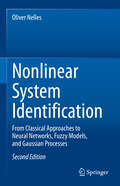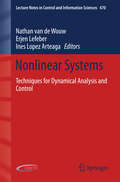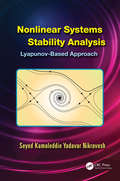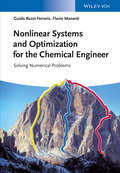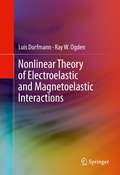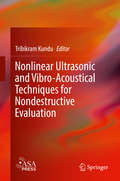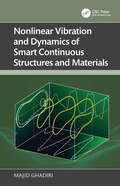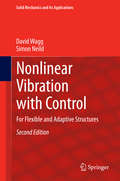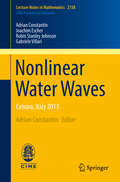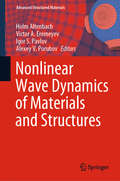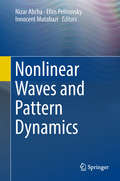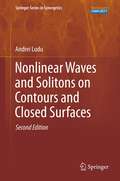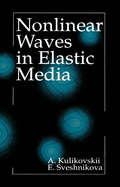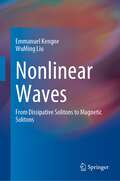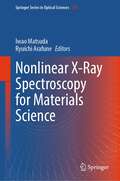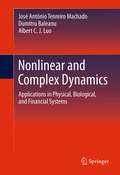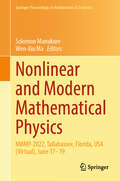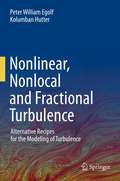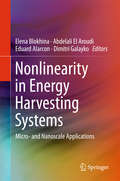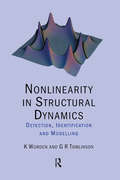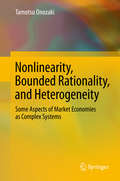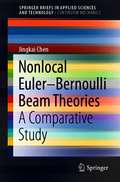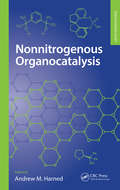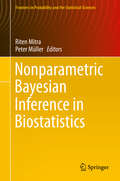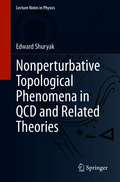- Table View
- List View
Nonlinear System Identification: From Classical Approaches to Neural Networks, Fuzzy Models, and Gaussian Processes
by Oliver NellesThis book provides engineers and scientists in academia and industry with a thorough understanding of the underlying principles of nonlinear system identification. It equips them to apply the models and methods discussed to real problems with confidence, while also making them aware of potential difficulties that may arise in practice. Moreover, the book is self-contained, requiring only a basic grasp of matrix algebra, signals and systems, and statistics. Accordingly, it can also serve as an introduction to linear system identification, and provides a practical overview of the major optimization methods used in engineering. The focus is on gaining an intuitive understanding of the subject and the practical application of the techniques discussed. The book is not written in a theorem/proof style; instead, the mathematics is kept to a minimum, and the ideas covered are illustrated with numerous figures, examples, and real-world applications. In the past, nonlinear system identification was a field characterized by a variety of ad-hoc approaches, each applicable only to a very limited class of systems. With the advent of neural networks, fuzzy models, Gaussian process models, and modern structure optimization techniques, a much broader class of systems can now be handled. Although one major aspect of nonlinear systems is that virtually every one is unique, tools have since been developed that allow each approach to be applied to a wide variety of systems.
Nonlinear Systems
by Nathan van de Wouw Erjen Lefeber Ines Lopez ArteagaThis treatment of modern topics relatedto the control of nonlinear systems is a collection of contributionscelebrating the work of Professor Henk Nijmeijer and honoring his 60thbirthday. It addresses several topics that have been the core of ProfessorNijmeijer's work, namely: the control of nonlinear systems, geometric controltheory, synchronization, coordinated control, convergent systems and thecontrol of underactuated systems. The book presents recent advances in theseareas, contributed by leading international researchers in systems and control. In addition to the theoretical questions treated in the text, particularattention is paid to a number of applications including (mobile) robotics,marine vehicles, neural dynamics and mechanical systems generally. This volume providesa broad picture of the analysis and control of nonlinear systems for scientistsand engineers with an interest in the interdisciplinary field of systems andcontrol theory. The reader will benefit from the expert participants' ideas on importantopen problems with contributions that represent the state of the art innonlinear control.
Nonlinear Systems Stability Analysis: Lyapunov-Based Approach
by Seyed Kamaleddin NikraveshThe equations used to describe dynamic properties of physical systems are often nonlinear, and it is rarely possible to find their solutions. Although numerical solutions are impractical and graphical techniques are not useful for many types of systems, there are different theorems and methods that are useful regarding qualitative properties of nonlinear systems and their solutions—system stability being the most crucial property. Without stability, a system will not have value.Nonlinear Systems Stability Analysis: Lyapunov-Based Approach introduces advanced tools for stability analysis of nonlinear systems. It presents the most recent progress in stability analysis and provides a complete review of the dynamic systems stability analysis methods using Lyapunov approaches. The author discusses standard stability techniques, highlighting their shortcomings, and also describes recent developments in stability analysis that can improve applicability of the standard methods. The text covers mostly new topics such as stability of homogonous nonlinear systems and higher order Lyapunov functions derivatives for stability analysis. It also addresses special classes of nonlinear systems including time-delayed and fuzzy systems.Presenting new methods, this book provides a nearly complete set of methods for constructing Lyapunov functions in both autonomous and nonautonomous systems, touching on new topics that open up novel research possibilities. Gathering a body of research into one volume, this text offers information to help engineers design stable systems using practice-oriented methods and can be used for graduate courses in a range of engineering disciplines.
Nonlinear Systems and Optimization for the Chemical Engineer
by Guido Buzzi-Ferraris Flavio ManentiThis third book in a suite of four practical guides is an engineer's companion to using numerical methods for the solution of complex mathematical problems. The required software is provided by way of the freeware mathematical library BzzMath that is developed and maintained by the authors. The present volume focuses on optimization and nonlinear systems solution. The book describes numerical methods, innovative techniques and strategies that are all implemented in a well-established, freeware library. Each of these handy guides enables the reader to use and implement standard numerical tools for their work, explaining the theory behind the various functions and problem solvers, and showcasing applications in diverse scientific and engineering fields. Numerous examples, sample codes, programs and applications are proposed and discussed. The book teaches engineers and scientists how to use the latest and most powerful numerical methods for their daily work.
Nonlinear Theory of Electroelastic and Magnetoelastic Interactions
by Luis Dorfmann Ray W. OgdenThis book provides a unified theory on nonlinear electro-magnetomechanical interactions of soft materials capable of large elastic deformations. The authors include an overview of the basic principles of the classic theory of electromagnetism from the fundamental notions of point charges and magnetic dipoles through to distributions of charge and current in a non-deformable continuum, time-dependent electromagnetic fields and Maxwell's equations. They summarize relevant theories of continuum mechanics, required to account for the deformability of material and present a constitutive framework for the nonlinear magneto-and electroelastic interactions in a highly deformable material. The equations contained in the book formulate and solve a variety of representative boundary-value problems for both nonlinear magnetoelasticity and electroelasticity.
Nonlinear Ultrasonic and Vibro-Acoustical Techniques for Nondestructive Evaluation
by Tribikram KunduThis multi-contributed volume provides a practical, applications-focused introduction to nonlinear acoustical techniques for nondestructive evaluation. Compared to linear techniques, nonlinear acoustical/ultrasonic techniques are much more sensitive to micro-cracks and other types of small distributed damages. Most materials and structures exhibit nonlinear behavior due to the formation of dislocation and micro-cracks from fatigue or other types of repetitive loadings well before detectable macro-cracks are formed. Nondestructive evaluation (NDE) tools that have been developed based on nonlinear acoustical techniques are capable of providing early warnings about the possibility of structural failure before detectable macro-cracks are formed. This book presents the full range of nonlinear acoustical techniques used today for NDE. The expert chapters cover both theoretical and experimental aspects, but always with an eye towards applications. Unlike other titles currently available, which treat nonlinearity as a physics problem and focus on different analytical derivations, the present volume emphasizes NDE applications over detailed analytical derivations. The introductory chapter presents the fundamentals in a manner accessible to anyone with an undergraduate degree in Engineering or Physics and equips the reader with all of the necessary background to understand the remaining chapters. This self-contained volume will be a valuable reference to graduate students through practising researchers in Engineering, Materials Science, and Physics.Represents the first book on nonlinear acoustical techniques for NDE applicationsEmphasizes applications of nonlinear acoustical techniquesPresents the fundamental physics and mathematics behind nonlinear acoustical phenomenon in a simple, easily understood mannerCovers a variety of popular NDE techniques based on nonlinear acoustics in a single volume
Nonlinear Vibration and Dynamics of Smart Continuous Structures and Materials
by Majid GhadiriNonlinear Vibration and Dynamics of Smart Continuous Structures and Materials delves into intricate subjects concerning the analysis of nonlinear vibration issues in continuous structures. It covers general concepts and a history of nonlinear systems before evolving into kinetics and solution methods of continuous structures.Exploring the implementation of new types of materials in various sectors of automobile, aerospace, and structural engineering, the book provides applicable information on the behaviors of smart structures. The book provides a set of mathematical formulations to solve nonlinear static and dynamic behaviors of smart continuous structures by applying principles of elasticity.The book will interest academic researchers and graduate students studying structural engineering, mechanics of solids, and smart materials.
Nonlinear Vibration with Control
by David Wagg Simon NeildThis book provides a comprehensive discussion of nonlinear multi-modal structural vibration problems, and shows how vibration suppression can be applied to such systems by considering a sample set of relevant control techniques. It covers the basic principles of nonlinear vibrations that occur in flexible and/or adaptive structures, with an emphasis on engineering analysis and relevant control techniques. Understanding nonlinear vibrations is becoming increasingly important in a range of engineering applications, particularly in the design of flexible structures such as aircraft, satellites, bridges, and sports stadia. There is an increasing trend towards lighter structures, with increased slenderness, often made of new composite materials and requiring some form of deployment and/or active vibration control. There are also applications in the areas of robotics, mechatronics, micro electrical mechanical systems, non-destructive testing and related disciplines such as structural health monitoring. Two broader themes cut across these application areas: (i) vibration suppression - or active damping - and, (ii) adaptive structures and machines. In this expanded 2nd edition, revisions include: An additional section on passive vibration control, including nonlinear vibration mounts. A more in-depth description of semi-active control, including switching and continuous schemes for dampers and other semi-active systems. A complet e reworking of normal form analysis, which now includes new material on internal resonance, bifurcation of backbone curves and stability analysis of forced responses. Further analysis of the nonlinear dynamics of cables including internal resonance leading to whirling. Additional material on the vibration of systems with impact friction. The book is accessible to practitioners in the areas of application, as well as students and researchers working on related topics. In particular, the aim is to introduce the key concepts of nonlinear vibration to readers who have an understanding of linear vibration and/or linear control, but no specialist knowledge in nonlinear dynamics or nonlinear control.
Nonlinear Water Waves
by Adrian Constantin Joachim Escher Robin Stanley Stanley Johnson Gabriele Villariadrian ConstantinThis volumebrings together four lecture courses on modern aspects of water waves. Theintention, through the lectures, is to present quite a range of mathematicalideas, primarily to show what is possible and what, currently, is of particularinterest. Water wavesof large amplitude can only be fully understood in terms of nonlinear effects,linear theory being not adequate for their description. Taking advantage ofinsights from physical observation, experimental evidence and numericalsimulations, classical and modern mathematical approaches can be used to gaininsight into their dynamics. The book presents several avenues and offers awide range of material of current interest. Thelectures provide a useful source for those who want to begin to investigate howmathematics can be used to improve our understanding of water wave phenomena. In addition, some of the material can be used by those who are already familiarwith one branch of the study of water waves, to learn more about other areas.
Nonlinear Wave Dynamics of Materials and Structures (Advanced Structured Materials #122)
by Holm Altenbach Victor A. Eremeyev Alexey V. Porubov Igor S. PavlovThis book marks the 60th birthday of Prof. Vladimir Erofeev – a well-known specialist in the field of wave processes in solids, fluids, and structures. Featuring a collection of papers related to Prof. Erofeev’s contributions in the field, it presents articles on the current problems concerning the theory of nonlinear wave processes in generalized continua and structures. It also discusses a number of applications as well as various discrete and continuous dynamic models of structures and media and problems of nonlinear acoustic diagnostics.
Nonlinear Waves and Pattern Dynamics
by Efim Pelinovsky Nizar Abcha Innocent MutabaziThis book addresses the fascinating phenomena associated with nonlinear waves and spatio-temporal patterns. These appear almost everywhere in nature from sand bed forms to brain patterns, and yet their understanding still presents fundamental scientific challenges. The reader will learn here, in particular, about the current state-of-the art and new results in: Nonlinear water waves: resonance, solitons, focusing, Bose-Einstein condensation, as well as and their relevance for the sea environment (sea-wind interaction, sand bed forms, fiber clustering) Pattern formation in non-equilibrium media: soap films, chimera patterns in oscillating media, viscoelastic Couette-Taylor flow, flow in the wake behind a heated cylinder, other pattern formation. The editors and authors dedicate this book to the memory of Alexander Ezersky, Professor of Fluid Mechanics at the University of Caen Normandie (France) from September 2007 to July 2016. Before 2007, he had served as a Senior Scientist at the Institute of Applied Physics of the Russian Academy of Sciences in Nizhny Novgorod (Russia). The chapters have been written by leading scientists in Nonlinear Physics, and the topics chosen so as to cover all the fields to which Prof. Ezersky himself contributed, by means of experimental, theoretical and numerical approaches. The volume will appeal to advanced students and researchers studying nonlinear waves and pattern dynamics, as well as other scientists interested in their applications in various natural media.
Nonlinear Waves and Solitons on Contours and Closed Surfaces
by Andrei LuduThis volume is an introduction to nonlinear waves and soliton theory in the special environment of compact spaces such a closed curves and surfaces and other domain contours. It assumes familiarity with basic soliton theory and nonlinear dynamical systems. The first part of the book introduces the mathematical concept required for treating the manifolds considered, providing relevant notions from topology and differential geometry. An introduction to the theory of motion of curves and surfaces - as part of the emerging field of contour dynamics - is given. The second and third parts discuss the modeling of various physical solitons on compact systems, such as filaments, loops and drops made of almost incompressible materials thereby intersecting with a large number of physical disciplines from hydrodynamics to compact object astrophysics. This book is intended for graduate students and researchers in mathematics, physics and engineering. This new edition has been thoroughly revised, expanded and updated.
Nonlinear Waves in Elastic Media
by A.G. Kulikovskii Elena I. SveshnikovaNonlinear Waves in Elastic Media explores the theoretical results of one-dimensional nonlinear waves, including shock waves, in elastic media. It is the first book to provide an in-depth and comprehensive presentation of the nonlinear wave theory while taking anisotropy effects into account. The theory is completely worked out and draws on 15 years of research by the authors, one of whom also wrote the 1965 classic Magnetohydrodynamics. Nonlinear Waves in Elastic Media emphasizes the behavior of quasitransverse waves and analyzes arbitrary discontinuity disintegration problems, illustrating that the solution can be non-unique - a surprising result. The solution is shown to be especially interesting when anisotropy and nonlinearity effects interact, even in small-amplitude waves. In addition, the text contains an independent mathematical chapter describing general methods to study hyperbolic systems expressing the conservation laws. The theoretical results described in Nonlinear Waves in Elastic Media allow, for the first time, discovery and interpretation of many new peculiarities inherent to the general problem of discontinuous solutions and so provide a valuable resource for advanced students and researchers involved with continuum mechanics and partial differential equations.
Nonlinear Waves: From Dissipative Solitons to Magnetic Solitons
by Emmanuel Kengne WuMing LiuThis book highlights the methods to engineer dissipative and magnetic nonlinear waves propagating in nonlinear systems. In the first part of the book, the authors present methodologically mathematical models of nonlinear waves propagating in one- and two-dimensional nonlinear transmission networks without/with dissipative elements. Based on these models, the authors investigate the generation and the transmission of nonlinear modulated waves, in general, and solitary waves, in particular, in networks under consideration. In the second part of the book, the authors develop basic theoretical results for the dynamics matter-wave and magnetic-wave solitons of nonlinear systems and of Bose–Einstein condensates trapped in external potentials, combined with the time-modulated nonlinearity. The models treated here are based on one-, two-, and three-component non-autonomous Gross–Pitaevskii equations. Based on the Heisenberg model of spin–spin interactions, the authors also investigate the dynamics of magnetization in ferromagnet with or without spin-transfer torque. This research book is suitable for physicists, mathematicians, engineers, and graduate students in physics, mathematics, and network and information engineering.
Nonlinear X-Ray Spectroscopy for Materials Science (Springer Series in Optical Sciences #246)
by Iwao Matsuda Ryuichi ArafuneX-ray experiments have been used widely in materials science, and conventional spectroscopy has been based on linear responses in light–matter interactions. Recent development of ultrafast light sources of tabletop lasers and X-ray free electron lasers reveals nonlinear optical phenomena in the X-ray region, and the measurement signals have been found to carry a further wealth of information on materials. This book overviews such nonlinear X-ray spectroscopy and its related issues for materials science. Each chapter is written by pioneers in the field and skillfully reviews the topics of nonlinear spectroscopy including X-ray multi-photon absorption and X-ray second harmonic generation. The chapters are divided depending on photon wavelength, ranging from extreme ultraviolet to (soft) X-ray. To facilitate readers’ comprehensive understanding, some of the chapters cover the conventional linear X-ray spectroscopy and basic principles of the non-linear responses. The book is mainly accessible as a primer for junior/senior- or graduate-level readers, and it also serves as a useful reference or guide even for established researchers in optical spectroscopy. The book offers readers opportunities to benefit from cutting-edge research in this new area of nonlinear X-ray spectroscopy.
Nonlinear and Complex Dynamics
by Albert C. Luo José António Machado Dumitru BaleanuNonlinear Dynamics of Complex Systems describes chaos, fractal and stochasticities within celestial mechanics, financial systems and biochemical systems. Part I discusses methods and applications in celestial systems and new results in such areas as low energy impact dynamics, low-thrust planar trajectories to the moon and earth-to-halo transfers in the sun, earth and moon. Part II presents the dynamics of complex systems including bio-systems, neural systems, chemical systems and hydro-dynamical systems. Finally, Part III covers economic and financial systems including market uncertainty, inflation, economic activity and foreign competition and the role of nonlinear dynamics in each.
Nonlinear and Modern Mathematical Physics: NMMP-2022, Tallahassee, Florida, USA (Virtual), June 17–19 (Springer Proceedings in Mathematics & Statistics #459)
by Solomon Manukure Wen-Xiu MaThis book gathers peer-reviewed, selected contributions from participants of the 6th International Workshop on Nonlinear and Modern Mathematical Physics (NMMP-2022), hosted virtually from June 17–19, 2022. Works contained in this volume cover topics like nonlinear differential equations, integrable systems, Hamiltonian systems, inverse scattering transform, Painleve's analysis, nonlinear wave phenomena and applications, numerical methods of nonlinear wave equations, quantum integrable systems, and more. In this book, researchers and graduate students in mathematics and related areas will find new methods and tools that only recently have been developed to solve nonlinear problems. The sixth edition of the NMMP workshop was organized by Florida A&M University in Tallahassee, Florida, USA, with support from the University of South Florida, Florida State University, Embry-Riddle Aeronautical University, Savannah State University, Prairie View A&M University, and Beijing Jiaotong University. The aim was to bring together researchers from around the world to present their findings and foster collaboration for future research.
Nonlinear, Nonlocal and Fractional Turbulence: Alternative Recipes for the Modeling of Turbulence
by Kolumban Hutter Peter William EgolfExperts of fluid dynamics agree that turbulence is nonlinear and nonlocal. Because of a direct correspondence, nonlocality also implies fractionality. Fractional dynamics is the physics related to fractal (geometrical) systems and is described by fractional calculus. Up-to-present, numerous criticisms of linear and local theories of turbulence have been published. Nonlinearity has established itself quite well, but so far only a very small number of general nonlocal concepts and no concrete nonlocal turbulent flow solutions were available. This book presents the first analytical and numerical solutions of elementary turbulent flow problems, mainly based on a nonlocal closure. Considerations involve anomalous diffusion (Lévy flights), fractal geometry (fractal-β, bi-fractal and multi-fractal model) and fractional dynamics. Examples include a new ‘law of the wall’ and a generalization of Kraichnan’s energy-enstrophy spectrum that is in harmony with non-extensive and non-equilibrium thermodynamics (Tsallis thermodynamics) and experiments. Furthermore, the presented theories of turbulence reveal critical and cooperative phenomena in analogy with phase transitions in other physical systems, e.g., binary fluids, para-ferromagnetic materials, etc.; the two phases of turbulence identifying the laminar streaks and coherent vorticity-rich structures. This book is intended, apart from fluids specialists, for researchers in physics, as well as applied and numerical mathematics, who would like to acquire knowledge about alternative approaches involved in the analytical and numerical treatment of turbulence.
Nonlinearity in Energy Harvesting Systems
by Abdelali El Aroudi Dimitri Galayko Elena Blokhina Eduard AlarconThis book is a single-source guide to nonlinearity and nonlinear techniques in energy harvesting, with a focus on vibration energy harvesters for micro and nanoscale applications. The authors demonstrate that whereas nonlinearity was avoided as an undesirable phenomenon in early energy harvesters, now it can be used as an essential part of these systems. Readers will benefit from an overview of nonlinear techniques and applications, as well as deeper insight into methods of analysis and modeling of energy harvesters, employing different nonlinearities. The role of nonlinearity due to different aspects of an energy harvester is discussed, including nonlinearity due to mechanical-to-electrical conversion, nonlinearity due to conditioning electronic circuits, nonlinearity due to novel materials (e. g. , graphene), etc. Coverage includes tutorial introductions to MEMS and NEMS technology, as well as a wide range of applications, such as nonlinear oscillators and transducers for energy harvesters and electronic conditioning circuits for effective energy processing.
Nonlinearity in Structural Dynamics: Detection, Identification and Modelling
by K WordenMany types of engineering structures exhibit nonlinear behavior under real operating conditions. Sometimes the unpredicted nonlinear behavior of a system results in catastrophic failure. In civil engineering, grandstands at sporting events and concerts may be prone to nonlinear oscillations due to looseness of joints, friction, and crowd movements.
Nonlinearity, Bounded Rationality, and Heterogeneity: Some Aspects of Market Economies as Complex Systems
by Tamotsu OnozakiThis book follows a nonlinear approach in considering both chaotic dynamical models and agent-based simulation models of economics as well as their dynamical behaviors. Three key words arising in this context are "nonlinearity", "bounded rationality" and "heterogeneity", which make up the title of the book. Nonlinearity is the warp that runs throughout all models because systems that exhibit chaotic or other complex behavior in the absence of any exogenous disturbances are absolutely nonlinear. Bounded rationality constitutes the woof because economic systems do not exhibit complex behavior if all agents are perfectly rational as is usually assumed in neoclassical economics. Agents who are boundedly rational have to struggle to do their best under informational restriction and tend to adapt themselves to the economic environment without knowing what is the best. Furthermore, heterogeneity of firms or consumers dyes the fabric of complex dynamics woven from the warp and woof.
Nonlocal Euler–Bernoulli Beam Theories: A Comparative Study (SpringerBriefs in Applied Sciences and Technology)
by Jingkai ChenThis book presents a comparative study on the static responses of the Euler-Bernoulli beam governed by nonlocal theories, including the Eringen’s stress-gradient beam theory, the Mindlin’s strain-gradient beam theory, the higher-order beam theory and the peridynamic beam theory. Benchmark examples are solved analytically and numerically using these nonlocal beam equations, including the simply-supported beam, the clamped-clamped beam and the cantilever beam. Results show that beam deformations governed by different nonlocal theories at different boundary conditions show complex behaviors. Specifically, the Eringen’s stress-gradient beam equation and the peridynamic beam equation yield a much softer beam deformation for simply-supported beam and clamped-clamped beam, while the beam governed by the Mindlin’s strain-gradient beam equation is much stiffer. The cantilever beam exhibits a completely different behavior. The higher-order beam equation can be stiffer or softer depending on the values of the two nonlocal parameters. Moreover, the deformation fluctuation of the truncated order peridynamic beam equation is observed and explained from the singularity aspect of the solution expression. This research casts light on the fundamental explanation of nonlocal beam theories in nano-electromechanical systems.
Nonnitrogenous Organocatalysis (Organocatalysis Series)
by Andrew HarnedSince the 1990s the synthetic community has shown a growing interest in the development of catalytic reactions that employ entirely organic catalysts – so-called ‘organocatalysts’. With the current emphasis on green chemistry throughout the chemical industry, organocatalysis has become indispensible. In spite of this growth and recognition, there can be a misconception that organocatalysts are only based on nitrogen-containing functional groups (amines, ureas, and quaternary ammonium salts, for example), and are only useful for asymmetric reactions. <P><P> Nonnitrogenous Organocatalysis shows that the umbrella of organocatalysis covers other main group elements besides nitrogen, and the coverage is not just limited to asymmetric methods. Many of the catalysts and mechanisms discussed may not have a viable asymmetric variant or cannot be rendered asymmetric at all. This does not make them any less useful, as illustrated in this book.
Nonparametric Bayesian Inference in Biostatistics
by Peter Müller Riten MitraAs chapters in this book demonstrate, BNP has important uses in clinical sciences and inference for issues like unknown partitions in genomics. Nonparametric Bayesian approaches (BNP) play an ever expanding role in biostatistical inference from use in proteomics to clinical trials. Many research problems involve an abundance of data and require flexible and complex probability models beyond the traditional parametric approaches. As this book's expert contributors show, BNP approaches can be the answer. Survival Analysis, in particular survival regression, has traditionally used BNP, but BNP's potential is now very broad. This applies to important tasks like arrangement of patients into clinically meaningful subpopulations and segmenting the genome into functionally distinct regions. This book is designed to both review and introduce application areas for BNP. While existing books provide theoretical foundations, this book connects theory to practice through engaging examples and research questions. Chapters cover: clinical trials, spatial inference, proteomics, genomics, clustering, survival analysis and ROC curve.
Nonperturbative Topological Phenomena in QCD and Related Theories (Lecture Notes in Physics #977)
by Edward ShuryakThis book introduces a variety of aspects in nonperturbative Quantum Chromodynamics (QCD), focusing on the topological objects present in gauge theories. These objects, like magnetic monopoles, instantons, instanto-dysons, sphalerons, QCD flux tubes, etc, are first introduced individually and, later, treated collectively. As ensembles, they produce various phenomena that can be modeled numerically in lattice gauge theories and such collective effects, produced on the lattice, are extensively discussed in some chapters. In turn, the notion of duality, which is crucial in modern field/string theories, is elucidated by taking into consideration the electric-magnetic duality, the Poisson duality, and the AdS/CFT duality. This monograph is based on various lectures given by Edward Shuryak at Stony Brook during the last three decades and it is meant for advanced graduate students and young researchers in theoretical and mathematical physics who are willing to consolidate their knowledge in the topological phenomena encountered in fundamental QCD research.
